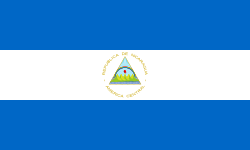Apoyeque
| Apoyeque | |
| Sköldvulkan | |
Chiltepe halvön med Apoyeques två kratersjöar | |
| Land | |
|---|---|
| Departement | Managua |
| Kommun | Mateare |
| Höjdläge | 518 m ö.h. |
| Koordinater | 12°14′42″N 86°20′33″V / 12.245083°N 86.342568°V |
| Tidszon | CST (UTC-6) |
Apoyeque är en 518 meter hög sköldvulkan i naturreservatet Pensinsula Chiltepe i Nicaragua. Den ligger på Chiltepe halvön i kommunen Mateare, 5 km nordost om Managua. Vulkanen hade sitt senaste utbrott cirka 50 f.kr.[1][2][3]
Kratersjöar

Vid toppen av Apoyeque finns en 2 km² stor kratersjö med grönaktigt vatten, vid namn Laguna de Apoyeque. Den har inget utlopp utan dräneras genom grundvattnet.[1][4]
En kilometer sydost om Laguna de Apoyeque finns ytterligare en kratersjö, vid namn Laguna de Xiloá, med rent vatten och många fiskar. Sjön är ett populärt utflyktsmål med restauranger och fina badmöjligheter.[1]
Naturreservat
Apoyeque ligger i naturreservatet Reserva Natural Pensinsula Chiltepe. Där finns ett rikt fågelliv.[1]
Referenser
- ^ [a b c d] Juan Echánove och Joaquim Rabella, La guía de Nicaragua, 3a edicón, Editorial Hispamer, 2011.
- ^ ”Zonu.com, Mapas Departamentos de Nicaragua”. Arkiverad från originalet den 26 november 2016. https://web.archive.org/web/20161126115038/http://www.zonu.com/mapas_nicaragua/Mapas_Mapa_Satelital_Foto_Imagen_Satelite_Nicaragua_2.htm#departamentos. Läst 6 mars 2024.
- ^ Smithonian Institution, Global Volcanism Program, Apoyeque
- ^ U.S. National Imagery and Mapping Agency, Nicaragua Topographical Maps, 1:50,000
Media som används på denna webbplats
Författare/Upphovsman: Alexrk2, Licens: CC BY-SA 3.0
Physical Location map Nicaragua with Departamentos, Equirectangular projection, N/S stretching 100 %. Geographic limits of the map:
Shiny red button/marker widget. Used to mark the location of something such as a tourist attraction.
Författare/Upphovsman: Haplochromis, Licens: CC BY-SA 3.0
Amatitlania siquia from Lake Xiloá
Apoyeque Volcano, Nicaragua is featured in this image photographed by an Expedition 38 crew member on the International Space Station.
- The Chiltepe Peninsula, highlighted in this photograph, extends into Lake Managua in west-central Nicaragua. The peninsula is formed from part of a large ignimbrite shield, a geologic structure created by deposition of primarily low density materials (such as pumice) ejected during violent, explosive eruptive activity. Ignimbrite deposits are most commonly emplaced during large pyroclastic flows - gravity-driven mixtures of rock, ash, and volcanic gases that can cover hundreds of kilometers at speeds of hundreds of kilometers per hour - with ignimbrite shields formed over geologic time by successive flows.
- The Apoyeque caldera, filled with a 2.8-kilometer-wide and 400-meter-deep lake, dominates the center of the peninsula. Geological evidence indicates that Apoyeque last erupted around 50 BCE (plus or minus 100 years). The Laguna Xiloa maar - a volcanic crater formed by the explosive interaction of magma and groundwater - is located immediately to the southeast of Apoyeque and is also filled with a lake. According to scientists, Laguna Xiloa last erupted approximately 6,100 years ago.
- More recently, a swarm of small earthquakes was detected near Apoyeque in 2012. These seismic swarms, when detected in volcanically active areas, may indicate movement of magma prior to an eruption. The capital city of Managua, not visible in the image, is located approximately 15 kilometers to the southeast of Apoyeque, while the town of Bosques de Xiloa is considerably closer (approximately four kilometers).






